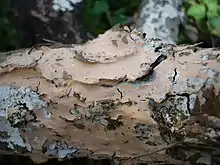Corticiales
The Corticiales are an order of fungi in the class Agaricomycetes. The order is composed of corticioid fungi. Species within the order are generally saprotrophic, most of them wood-rotters, but several are parasitic on grasses or lichens. Plant pathogens of economic importance include Erythricium salmonicolor, Laetisaria fuciformis, Waitea circinata, Waitea oryzae, and Waitea zeae.
| Corticiales | |
|---|---|
 | |
| Erythricium laetum | |
| Scientific classification | |
| Domain: | Eukaryota |
| Kingdom: | Fungi |
| Division: | Basidiomycota |
| Class: | Agaricomycetes |
| Order: | Corticiales K.-H. Larsson (2007) |
| Families | |
|
Corticiaceae | |
| Synonyms[1] | |
|
1907 Protohymeniales Lotsy | |
Taxonomy
The order was established in 2007 by Swedish mycologist Karl-Henrik Larsson, based on molecular phylogenetic research.[2] It includes the Corticiaceae (the type family) as well as the Dendrominiaceae, Punctulariaceae, and Vuilleminiaceae.[3]
Habitat and distribution
The order is cosmopolitan and contains around 150 species of fungi worldwide.[4] The majority of species in the Corticiales are saprotrophs, most of them wood-rotters, typically found on dead attached branches. Some species of Laetisaria are facultative or obligate parasites of grasses; some species of Erythricium and Waitea are also facultative plant parasites; and some species of Erythricium. Laetisaria, and Marchandiomyces are parasites of lichens.[5]
Economic importance
Erythricium salmonicolor is an important plant pathogen causing "pink disease" of Citrus and other trees. Waitea oryzae and Waitea zeae are pathogens of commercial cereal crops, causing a number of diseases including sheath spot of rice.[6] Waitea circinata causes brown ring patch in turf grasses.[7] Laetisaria fuciformis is the cause of red thread disease in turf grass.[8]
References
- "Corticiales K.H. Larss. 2007". MycoBank. International Mycological Association. Retrieved 2010-12-03.
- Hibbett DS; et al. (2007). "A higher level phylogenetic classification of the Fungi". Mycological Research. 111 (5): 509–547. CiteSeerX 10.1.1.626.9582. doi:10.1016/j.mycres.2007.03.004. PMID 17572334. S2CID 4686378.
- Ghobad-Nejhad M; Nilsson RH; Hallenberg, Hallenberg, N (2010). "Phylogeny and taxonomy of the genus Vuilleminia (Basidiomycota) based on molecular and morphological evidence, with new insights into Corticiales". Taxon. 59 (5): 1519–1534. doi:10.1002/tax.595016.
{{cite journal}}: CS1 maint: multiple names: authors list (link) - Kirk PM, Cannon PF, Minter DW, Stalpers JA (2008). Dictionary of the Fungi (10th ed.). Wallingford, UK: CABI. pp. 12–13. ISBN 978-0-85199-826-8.
- Lawrey JD, Diederich P, Sikaroodi M, Gillevet PM (2010). "Remarkable nutritional diversity of basidiomycetes in the Corticiales". American Journal of Botany. 95 (7): 816–823. doi:10.3732/ajb.0800078. PMID 21632407.
- Lanoiselet VM, Cother EJ, Ash GJ (2007). "Aggregate sheath spot and sheath spot of rice". Crop Protection. 26 (6): 799–808. doi:10.1016/j.cropro.2006.06.016.
- Toda T, Mushika T, Hayakawa T, Tanaka A, Tani T, Hayakumachi M (2005). "Brown Ring Patch: A new disease on bentgrass caused by Waitea circinata var. circinata". Plant Disease. 89 (6): 536–542. doi:10.1094/PD-89-0536. PMID 30795375.
- "Red Thread lawn disease - cause, symptoms and treatment". Retrieved 2010-12-03.